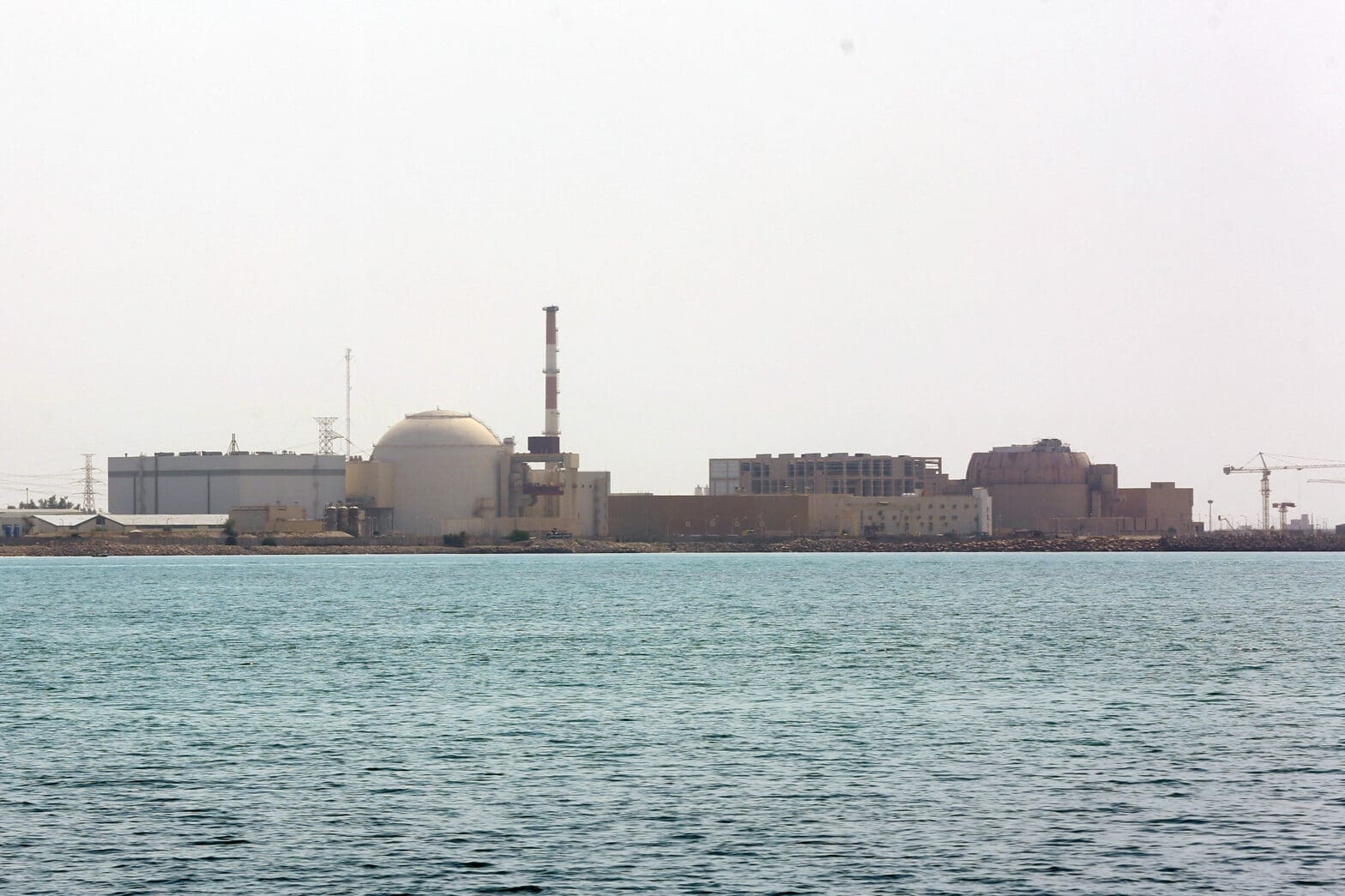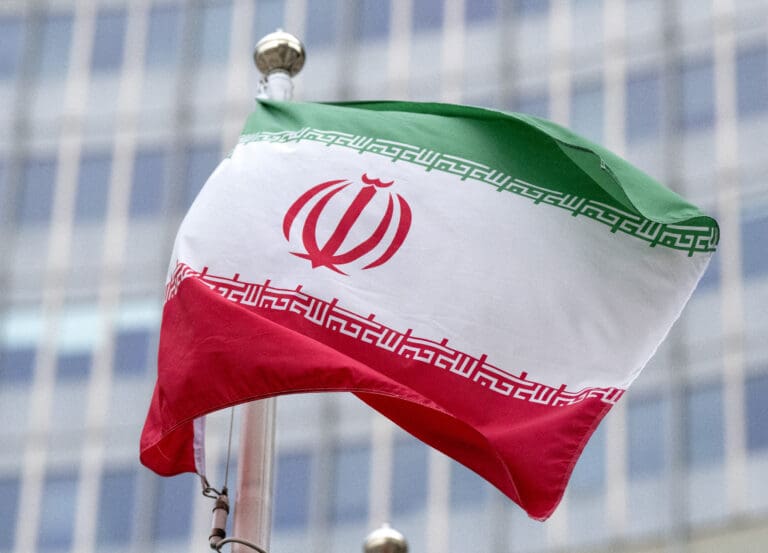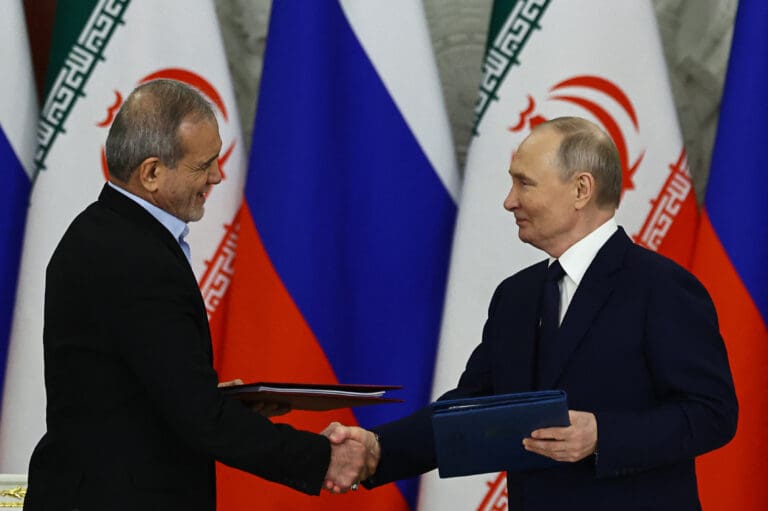
Iran’s Shifting Discourse on Nuclear Weaponization:
Bargaining Tactic or Doctrine Change?
Issue Brief
Issue Brief, November 2024
Key Takeaways
Heightening Threat Perception is the Main Driver of a Discourse Shift: Iran’s rhetoric shift toward nuclear armament is largely driven by external pressures, including Israel’s ongoing war on Gaza, and the wider region, along with its nuclear capabilities, and the limits of Iran’s conventional deterrence capabilities.
The Worst-Case Scenario: Iran may be preparing for a concrete move toward nuclear weaponization, either by gradually reaching the nuclear breakout point or by accelerating its push in that direction.
Potential Diplomatic Leverage: In the best-case scenario, this shift could be a strategy to raise the stakes in future negotiations, signaling that Iran may be open to broader discussions beyond the nuclear file, particularly regarding its regional security concerns.
Trump’s Re-Election is a Critical Factor: Trump’s return to the White House, with his history of “maximum pressure” on Iran and unwavering support for Israel, could heighten tensions and serve as a catalyst for Iran’s push toward nuclear weapons.
Introduction
At the end of August 2024, a, leaked, confidential report from the International Atomic Energy Agency (IAEA) raised concerns about the ongoing development of Iran’s nuclear program. The report criticized Iran’s lack of cooperation with the IAEA and warned that, if Iran increased its level of uranium enrichment, under current conditions, it would accumulate enough material to produce four nuclear bombs.1
Simultaneously, Iran’s Foreign Minister Abbas Araghchi stated that the Joint Comprehensive Plan of Action (JCPOA) was beyond revival, stressing the need to renegotiate parts of the nuclear agreement. 2
The statement marked a significant departure from Iran’s previous stance on the issue, which emphasized restoring the JCPOA as it was originally agreed upon in 2015.
These developments are unfolding in a highly volatile regional context, particularly amidst Israel’s ongoing war on Gaza and escalating confrontations between Iran and its allies on one side and Israel on the other. The assassination of prominent Hamas and Hezbollah leaders and the weakening of Iran-backed forces in the region, due to Israeli attacks, are likely further pushing Iranian leaders to rethink the effectiveness of their direct and indirect deterrents against Israel.
In this atmosphere of heightened tensions, calls to revise the country’s nuclear doctrine have increased in Iran. Some are arguing that it may be time for Iran to develop nuclear weapons as a more effective deterrent against its adversaries. This issue brief analyzes the recent shift in Iran’s nuclear discourse, explores the internal and external factors driving this change, and assesses potential scenarios that could emerge from these evolving dynamics. It also discusses the broader strategic implications for Iran and the region.
Changing Discourse
Tacit references to the possibility of Iran altering its stance on the acquisition of nuclear weapons are not new. In February 2021, Mahmoud Alavi, then Minister of Intelligence, stated that although Supreme Leader Ayatollah Khamenei had prohibited the development of nuclear weapons, Western countries’ increasing pressure on Tehran may force it to develop weapons of its own. Alavi explained that “a cornered cat may behave differently from when the cat is free. And if they [Western states] push Iran in that direction, then it’s no longer Iran’s fault.”3 This indirect reference to the potential development of nuclear weapons sparked considerable controversy, even prompting criticism from conservative and hardline media outlets in Iran.
They emphasized that Khamenei, as the political and religious leader, had repeatedly declared the development of nuclear weapons forbidden (harām), which, implicitly, took this option off the table.4
Statements from current and former officials, however, about the possibility and likelihood of Iran moving toward militarizing its nuclear program have become more direct and frequent over the past year. Notably, in February 2024, Ali Akbar Salehi, who served as Iran’s Foreign Minister from 2010 to 2013 and as the former head of the Atomic Energy Organization emphasized that “[Iran possesses] all the thresholds of nuclear science and technology.”5 While Salehi’s comments focused on Iran’s existing capabilities rather than the intent to develop nuclear weapons, Kamal Kharrazi, a senior advisor to Khamenei and head of Iran’s Strategic Council on Foreign Relations (SCFR), dispelled any ambiguity.
Kharrazi asserted that, “[Iran has] no intention of producing a nuclear bomb, but if [its] existence is threatened, we will be forced to change our nuclear doctrine.”6
These comments followed Iran’s missile and drone attack on Israel, in April 2024, which came in response to an Israeli airstrike on Iran’s consulate in Damascus that same month. General Ahmad Haqtalab, an IRGC commander responsible for the security of Iran’s nuclear installations, echoed this position. Haqtalab underscored that Israel’s rising threats against Iran risk “a reconsideration of the Islamic Republic of Iran’s nuclear doctrine and policies, and a departure from previous declared considerations.”7 The statement was historic, marking the first time a military official explicitly addressed the issue of nuclear weapons.
Since then, discussions about the necessity of nuclear deterrence have also become routine in Iranian media, including on state radio and television. This is likely an indication of a broader shift in official discourse, considering the government’s tight control over national broadcasting outlets. Some members of parliament have even moved beyond hypothetical discussions, openly calling for the development of nuclear weapons.8
Causes and Drivers of the Discourse Shift
The ongoing war on Gaza, which has now expanded beyond Gaza, particularly into Lebanon, is a central driver of the shift in Iran’s nuclear discourse. The war has sharply escalated tensions between Iran and Israel, with both sides engaging in increasingly hostile rhetoric and actions. Iran’s support for Hamas and other members of the “Axis of Resistance” places it at the heart of regional tensions.
The war has also exposed the limits of Iran’s current deterrents, particularly as Israel continues to target Iranian assets, personnel, and allies across the region. Since Tehran’s large-scale attack on Israel in early 2024, Iranian officials have spoken of a new equation with Israel, declaring that any attack on Iranian interests in the region would prompt a direct response from Iran.9
However, Iran’s red line has been breached several times since then – particularly with the assassination of Hamas’ Political Bureau Chief Ismail Haniyeh in Tehran and Hezbollah’s Secretary-General Sayyed Hassan Nasrallah, just two months later, along with senior Iranian General Abbas Nilforoushan, who served as the IRGC’s Deputy Commander of Operations, in Beirut. Most notably, Israel’s October 26 attacks on Iran, reportedly targeting key facilities linked to Iran’s missile program, radar systems, and defense infrastructure, have intensified the challenges facing Tehran.10 These incidents suggest that Iran’s military threats and capabilities have thus far failed to effectively deter Israel.
Israel’s determination to significantly weaken Hezbollah, Iran’s most important regional ally, is a key concern for Iranian officials. Ideologically, Hezbollah and the Islamic Republic are deeply aligned, cementing the alliance’s importance for Tehran’s interests in the region. Lebanon’s strategic location, bordering Israel, also gives Iran direct leverage in any conflict with its primary adversary. Hezbollah has also played a key role in coordinating other groups within the “Axis of Resistance.” However, in just a few months, Hezbollah has lost nearly all of its prominent leaders as well as many mid- and lower-level commanders.
Tehran had been investing in building up Hezbollah, and other allied non-state groups, for four decades, with the expectation that they would serve as a critical pillar of deterrence against Israel. Iran’s strategy was largely based on the assumption that the threat of an indirect Iranian response through these groups would deter Israel from waging war against it. But domestic politics had complicated this relationship even before Israel’s attacks, as members of the Iran-backed networks assumed political roles within their own national contexts. While this strengthened the respective members’ own authority, it raised doubts around their effectiveness in advancing Iran’s strategic objectives.
Weakened capabilities of Iran’s regional allies, namely Hezbollah and Hamas, resulting from Israel’s continued and expanding military offensive has further challenged Iran’s “forward defense” doctrine of extraterritorial deterrence. Specifically, since October 7, 2023, Hamas’ military capabilities in Gaza have considerably weakened while Hezbollah now faces a similar decline in Lebanon.11
The narrative within Iran is consequently shifting toward viewing nuclear weapons as the ultimate deterrent against future Israeli aggression.
The developments in Gaza and the wider region have also strained Iran’s relations with Western powers, particularly as they continue to support Israel’s attacks against Iran and its allies. For Tehran, Western governments, primarily the United States, are complicit in Israel’s actions against Iran and its allies.12 In this context, Israel’s possession of nuclear weapons, coupled with Western backing, further heightens Iran’s threat perception.
For Iran, the threat is not merely hypothetical. Israeli officials have suggested using nuclear weapons in Gaza.13
Such statements, along with Israel’s apparent lack of clear red lines in deploying its military technology – evidenced by the pager attacks in Lebanon in September 2024 – have intensified Iran’s concerns. The attacks, attributed to Israeli intelligence, involved the simultaneous detonation of pagers and walkie-talkies used by Hezbollah members. The explosions caused significant strategic damage and resulted in numerous civilian casualties.
The growing perception is that establishing a nuclear balance might be Iran’s only route to achieve effective deterrence. Beyond regional factors, global nuclear proliferation dynamics are also playing a role in shaping Iran’s nuclear calculus. Influential Iranian think tanks, such as the SCFR, highlight how the war in Ukraine has brought nuclear competition back to the forefront of relations between major powers, particularly the United States and Russia.14 The suspension of the New START treaty15 and discussions about changes to Russia’s nuclear doctrine, including the lowering of thresholds for nuclear use, are also seen as significant factors in this evolving global nuclear landscape.
In the same vein, Iran views the AUKUS pact 16 as further evidence of the West’s commitment to nuclear competition, in this case, with China.17
A recent report from the Stockholm International Peace Research Institute (SIPRI) indicated that China has undertaken the largest recent stockpiling of nuclear warheads, highlighting shifting nuclear proliferation dynamics in the Pacific. Iranian policymakers are closely following these developments, which significantly shape their strategic goals.18
Economic pressures and ongoing Western sanctions against Iran cannot be overlooked. The U.S. withdrawal from the JCPOA in 2018 under Donald Trump prompted Iran to take reciprocal actions, which served as a justification for expanding its nuclear program. Despite early promises by President Joe Biden to return to the JCPOA, efforts have faltered, and U.S. sanctions against Iran have not only persisted but have, for various reasons, intensified further.
This situation has led some in Iran to argue that the country has been enduring the costs associated with acquiring nuclear weapons without actually possessing them. Ahmad Bakhshayesh Ardestani, a member of parliament, articulated this frustration in an interview, stating: “Neither is the JCPOA being revived, nor do we have a nuclear bomb; yet we are bearing sanctions as if we have one… Is this situation rational?”19 Mounting frustration over the lack of sanctions relief and economic improvement has therefore fueled arguments supporting Iran’s pursuit of nuclear weapons as a rational alternative.
Future Scenarios and Implications
Taken together, the aforementioned factors contribute to a growing perception, within a number of political circles in Iran, that there is an increasing possibility and necessity for building nuclear weapons. However, the most critical factor likely to influence any final decision toward weaponization is Iran’s evolving threat perception.
In the months following October 7, 2023, Iranian leaders were initially optimistic that regional and international developments – such as diplomatic pressure on Israel and military pressure from members of the “Axis of Resistance” – would lead to a meaningful and lasting shift in the regional balance of power in favor of Iran and its allies.20 This optimism has since faded, particularly after Israel’s unprecedented strikes on Hezbollah and expanding military offensive in Lebanon. It has also become apparent that diplomatic pressure has had little to no effect on Israel’s military-security approach.
The consolidation of the post-October 7 status quo, where Israel has gained a military advantage over Iran and its allies, could have consequences beyond the erosion of Iran’s asymmetric deterrence. An Israeli victory in the war– however defined – could drive Arab states to resume formal cooperation with Israel. This shift, coupled with a blow to Iran’s political and military credibility, would create a scenario Iran has long feared: an Arab-Israeli coalition. Despite Tehran’s ongoing diplomatic outreach to Arab states, such a coalition would heighten Iran’s threat perception within the region. These developments will likely further empower those within Iran advocating for nuclear weapons as “ultimate deterrence.”21
The decision to move toward nuclear weapons, however, would not be easy for Iran. The IAEA’s extensive inspections, coupled with Israeli intelligence’s deep penetration into Iran, evidenced by recent acts of sabotage and assassinations, suggest that any move toward nuclear breakout would likely be immediately detected. In this case, both Israel and potentially the United States might take preemptive action
Given these risks, Iran may opt for a more gradual approach, increasing its enrichment capacity without officially cutting off IAEA access or withdrawing from the Nuclear Non-Proliferation Treaty (NPT).22
This strategy would reduce the time needed for a nuclear breakout while also advancing the production of other key components necessary for weaponization, such as delivery systems and command and control structures.
In this scenario, Iran would become a fully-fledged “threshold state,” which some Iranian analysts describe as a strategy of “latent nuclear deterrence.”23 In other words, Iran would use its threshold capability and its growing potential for nuclear weaponization to deter foreign attacks against its civilian or nuclear infrastructure. If an attack were to occur, Tehran would rapidly advance on the final step and produce a nuclear weapon.
A second scenario is that Iran might not wait for an attack and instead take the initiative to build a nuclear weapon. While this carries the risk of a preemptive strike on Iran’s nuclear facilities, if Iranian leaders believe that such an attack is inevitable, they might view proceeding with developing nuclear weapons as a more viable option. Mohsen Rezaei, former chief commander of the IRGC and currently a senior IRGC military officer, recently argued that after Lebanon, Israel would target Syria, Iraq, and potentially Iran,24 reflecting the widespread sense of urgency and perception of an imminent threat that could catalyze Iran’s nuclear weaponization.
A third scenario could involve a new diplomatic approach from Tehran. Iranian officials, particularly President Masoud Pezeshkian, have recently expressed a willingness and readiness to resume diplomatic talks with Western countries, particularly concerning the nuclear issue. While Iran’s interest in diplomacy is not new, former President Ebrahim Raisi frequently stressed Iran’s interest in global and regional diplomatic efforts, this time Iranian officials are indicating a willingness to go beyond the nuclear file and engage on a broader range of political and security topics. For instance, Araghchi noted that during his visit to New York for the United Nations General Assembly, late 2024, he exchanged views with his European counterparts on various issues, including Ukraine and Lebanon. He also cautioned that “there is no other way to ensure the peaceful nature of Iran’s nuclear program except through negotiation.”25
In essence, Iran may be seeking to use its advanced nuclear program and the implicit threat of weaponization as leverage for broader diplomatic gains, potentially including security guarantees in the region. This approach, however, is fraught with complexity. It remains unclear what concessions Iran is currently prepared or able to offer. Returning to the JCPOA’s restrictions on uranium enrichment would effectively prevent Iran from playing the nuclear threshold game, a move likely to face significant opposition in Tehran.
The kind of regional agreements that would address Iran’s security concerns also remain uncertain, particularly given Tehran’s heightened threat perception from Israel, which is compounded by Western states’, namely the United States’, limited ability, or willingness, to influence Israel’s war on Gaza and the broader region. The recent escalation between Iran and Israel, marked by intense, direct strikes on each other’s territories, has significantly heightened the risk of Israel targeting Iran’s nuclear infrastructure. Although Israel’s October 26, 2024, attack focused solely on military sites, its strategic targeting of air defense and radar systems suggests it may be a prelude to broader assaults on Iranian nuclear infrastructure. Such an event would invariably shift Iran’s nuclear calculus, providing it with the justification needed to take the final step towards developing a nuclear weapon.
Conclusion
Since the onset of Iran’s nuclear crisis in 2003, senior Iranian officials have consistently emphasized the peaceful motivations of the country’s nuclear program and denied any intention to develop nuclear weapons. Officially, this stance remains firm and is frequently emphasized. However, outside the state’s official narrative, there is a growing and noticeable shift in discourse. This shift, largely communicated by state media and prominent political figures, seems to be an effort to prepare public opinion for a possible change in Iran’s nuclear doctrine. Whether this shift occurs will depend on various factors, crucially Iran’s threat perception and the outcome of diplomatic engagements between Tehran and the West.
In this context, the recent U.S. presidential election and the change in administration is a crucial factor. The re-election of Donald Trump, given his history of a “maximum pressure” policy toward Iran, could heighten tensions and potentially accelerate Iran’s move toward nuclear weaponization. On the one hand, some in Iran might argue that the country should already begin weaponizing its nuclear program, even before Trump officially takes office, to strengthen its position against the upcoming U.S. administration. On the other hand, Trump’s strong support for Israel – particularly for Netanyahu’s government – could embolden Israel to attack Iran’s nuclear facilities. Such an action might be the final catalyst that solidifies Tehran’s determination to develop a nuclear weapon.




